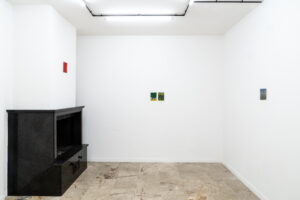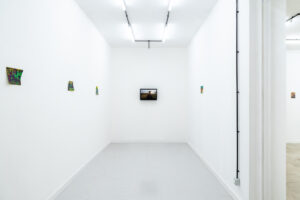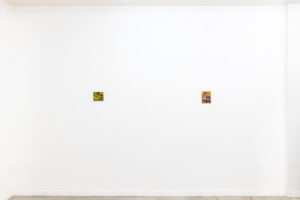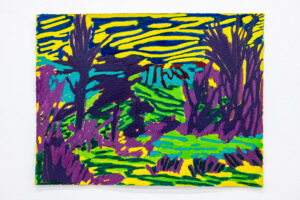Following an artist’s residency held in Pescara, David Hanes (1987, Toronto, Canada) opened in March, at Emerge Project Space, the exhibition “Gardens of Fate”. It is not the first time that Hanes faces in Italy: always in Pescara, in 2017, he was hosted by Ultrastudio; then in 2020, in Brescia, he was a guest of Spazio ORR; in 2022 in Rome, on the occasion of a shared staff with Richie Culver; to land in Tuscany, to the Villa Lena Foundation. “Gardens of Fate” explores the fundamental aspects of the artist’s changing research, focused on the relationship between art, nature and spirituality. The interview between Hanes and the author of the critical text, Benedetta Monti, touches on the main themes of the exhibition and the artist’s practice.

Gardens of Fate. Courtesy of the artist David Hanes and Emerge Project Space. Photo credits by Pierluigi Fabrizio and Giorgio Liddo
Benedetta Monti: “Today the landscape to cultivate is above all the mental one”, so declared in an interview Gianfranco Baruchello, enlightened and eclectic artist recently passed away. On the other hand, your landscape and your nature, so figurative and recognizable, are also tools to reflect on something else: something distant and at the same time close, but above all spiritual. The structured compositions from some sketches created en plein air suggest this. What is your urgency in creating?
David Hanes: Art has always been my connection to the outside world, and life has always made more sense to me at the time it is happening, because it connects me to the mystery of being alive, and that means existing in a constantly changing world. And, although I like this idea of the importance of the inner landscape, I have to contrast it with a unique perspective, which suggests that the real challenge is not only to form a healthy relationship with the inner landscape, but also with the outer one. I choose the subject of nature because I realize that it is my greatest teacher in building a healthier relationship with reality, and I try to listen to this personal suggestion. So my painting – what I paint in nature – is an attempt to get in touch with a specific place and bring it into the intimate area of my feeling. This is the spiritual perspective, a perspective that is both distant and close, such as longevity and mortality of consciousness. If engaging in the creative process is a gift to me, feeling stuck is equally. My life experience has always been combined with creativity, making my urge to create a life request.

Gardens of Fate. Courtesy of the artist David Hanes and Emerge Project Space. Photo credits by Pierluigi Fabrizio and Giorgio Liddo
What were the highlights of this residence for you? How has the city of Pescara influenced your production?
Although my time in Pescara was short, it was an important period for me, both in an imperceptible way and in an extraordinary and evident way. On the one hand, during my stay at Emerge, I noticed details about the wildflowers growing in the city and the looming presence of mountains in the distance, as well as the history of Canadians in Abruzzo. All this led me to paint in the mountains, in the countryside and in the Canadian war cemetery of Moro River, where I accidentally met a group of Canadian students from Yellowknife who were visiting monuments to the fallen throughout Europe. All this made me feel very lucky, and at the same time wild. Secondly, while I was in Pescara, the opportunity to walk along the waterfront helped me to make a decision about the next stages of my process and to hire my current painting mentor. That day by the sea influenced the direction my work will take. Needless to say it was a magical time and I am very grateful to the Emerge team for making me feel so welcome in Pescara.

Gardens of Fate. Courtesy of the artist David Hanes and Emerge Project Space. Photo credits by Pierluigi Fabrizio and Giorgio Liddo
Your work seems to be constantly fluctuating, as if you don’t want to limit the potential of your relationship with the subject, with the various media, with the changing research. How do you live this non-stylistic permanence?
It’s true that my artistic career has been exemplary of many states of change and experimentation, but I like to reflect on some of my heroes in the art world who have always advised me to be brave and bold in my work, to accept the challenges and to always listen to the work and what it is trying to say. Never be afraid of experimentation and change, otherwise it would mean working in fear and, when you do, the work slows down until it stops. However, I am at peace with where I am in my artistic process and with the fact that it led me to painting rather than another type of practice. It means I can continue to see the world and explore the interior and exterior seamlessly. It also brought me closer to my family, especially my mother. I live my practice as a landscape, or rather, as a mountain landscape like those of Abruzzo: full of valleys, peaks, municipalities, plains, lakes, cities, hills and cliffs.

Gardens of Fate. Courtesy of the artist David Hanes and Emerge Project Space. Photo credits by Pierluigi Fabrizio and Giorgio Liddo
Finally, before leaving, can you tell us what your next projects are?
I finished an artist’s residency at the Villa Lena Foundation in Tuscany, where I deepened my painting practice and produced my first etching with the printing studio Il Bisonte, in Florence. I am still in Italy thanks to the support of the Canadian Embassy; I will visit Turin, Milan and Bologna, before returning to Florence and following up some paintings that I left unfinished. After Italy, I will return to Berlin to paint for the upcoming projects for Copenhagen, Luxembourg and the United States. For the rest, I am excited to return for some time to Canada at the end of the year, to spend time painting in the north.
Benedetta Monti
Info:

is a contemporary art magazine since 1980






NO COMMENT